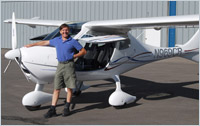In 2004, Light Sport Aircraft (LSA) became a new category the FAA created for aircraft that are simple, easy to fly and inexpensive to own and operate. To fly an LSA, you’ll need a Sport Pilot License, which is much easier to obtain than other more common pilot’s licenses. It does have some limitations, such as only flying during the day and only flying LSA certified aircraft. Soon I will post an article about the requirements for getting your Sport Pilot License. Read on for what constitutes a certified Light Sport Aircraft.
Actual aircraft models within the LSA category are extremely varied and include fixed wing, powered parachute, and weight-shift control categories. There is a number of existing “standard category” aircraft that meet the criteria of LSA, the most common of which is the Piper J-3 Cub. In the next few days, I’ll post FAQs that tell you about the different kinds of LSA aircraft, their maintenance and inspection requirements, as well as specific models of LSA. Subscribe to the newsletter or RSS feed to keep informed.
Regardless of the model, all LSA are guided by these specifications:
- Non-pressurized cockpit
- Two-person maximum, such as pilot and passenger or instructor and student
- Single reciprocating engine
- Fixed propeller and landing gear
- Maximum speed of 120 knots in level flight, full power
- Maximum stall speed of 45 knots
- Maximum gross weight of 1,320 lbs (1,430 lbs water)
For the newly certified LSA, there’s a Special Light Sport Aircraft (S-LSA) category. It represents a new set of rules that govern the design and manufacture of aircraft in the LSA category called “consensus standards” developed by industry and the ASTM, while being approved by the FAA. It allows pilots, manufacturers and the FAA to collaborate throughout this new process. Most significantly, this allows more control to be given to the aviation industry, and less to the government. It allows greater adaptability and quicker innovation; it also provides for an affordable certification for LSA.
What questions do you have about Light Sport Aircraft and the Sport Pilot License?
About Paul
Paul Hamilton is recognized as an expert in the Light Sport Aircraft (LSA) category. He is a pilot, flight instructor, aviation engineer, consultant, writer, video producer and business owner. Through his company, Adventure Productions, Paul specializes in teaching and informing people about flying (especially LSA) including students, pilots, instructors, mechanics, engineers and aerodynamicists.





